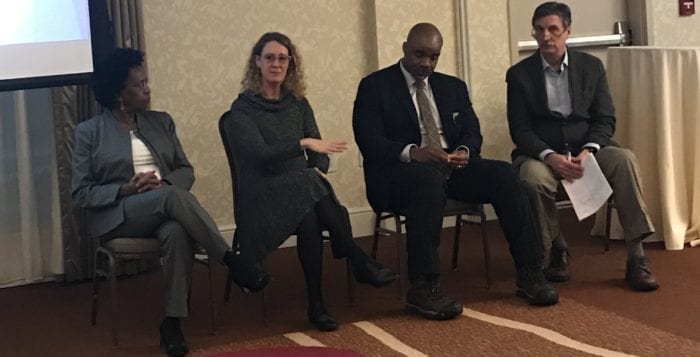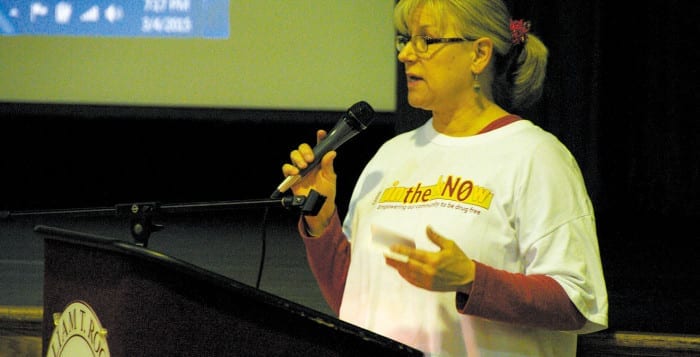By David Luces
While de facto segregation among Long Island’s school districts and housing has been entrenched for decades, there is a growing academic movement to bring people closer together.
As part of the forum, “Housing and Racio-economic Equality” Elaine Gross, president of the Syosset-based advocacy group ERASE Racism, which co-sponsored the event, along with professors from Duke and Johns Hopkins Universitys discussed the history of racism and segregation in the U.S. and how it has affected public housing and education. Gross argued that there is racial segregation and inequality crisis in housing and public education on Long Island.
“There are folks that think that things are fine how they are,” she said.
At the forum hosted at the Hilton Garden Inn at Stony Brook Univesrity, Gross argued that there is severe government fragmentation on Long Island, which in turn makes it easier for racial discrimination in housing and public education.
“Segregation is profitable, and it didn’t end — it is still ongoing.”
— Nathan Connolly
Nathan Connolly, a history professor at Johns Hopkins University, said we have to rethink what we know about segregation.
“We are under the impression that segregation ended due to a combination of moral arguments, like [Dr. Martin Luther King Jr.’s] I Have a Dream Speech, and that segregation was too expensive to maintain,” he said. “Segregation is profitable, and it didn’t end — it is still ongoing.”
Connolly added due to many Jim Crow era policies, white supremacy has been baked into our political and governing structure.
“In the 1920s people began to institutionalize groups like the Ku Klux Klan,” Connolly said. “They had chapters in cities like Detroit, Chicago and Washington, D.C.— it was a dominant force of political organization.”
In many ways, the experts argued Long Island, in terms of its development of housing, is the perfect picture of what structural racism looks like.
Gross stated some towns and school districts on Long Island are more segregated than others, showing areas like Levittown, whose black population has only risen 1.2 percent since 1947. At an ERASE Racism forum in December, Gross provided data from New York State Department of Education that shows a school district like Port Jefferson is made up of 80 percent white students, while in a district like Brentwood close to 80 percent of students are Latino while 12 percent are black.
The panelists argued this racial steering of populations dates back to the time of the Great Depression.
“[There was] a notion that anything that allowed unregulated movement of people would lead to economic instability,” Connolly said. “You had to generate a way to keep everyone in place, while at the same time ensuring broad economic growth.”
One way this was done was through redlining, or the denial of services to different races through raising the prices on services, or in this case, homes.
Connolly said by removing these people’s options in moving around or getting a loan with a low interest rate it meant they couldn’t own homes and couldn’t accumulate equity, which in turn generated a racial wealth gap.
Gross mentioned examples of this racial steering on Long Island. Three years ago in Commack, African American renters asked about vacancies at an apartment complex. They were told there were none. When white individuals asked, they were shown the vacancy, given applications and were encouraged to apply.
ERASE Racism, along with the nonprofit Fair Housing Justice Center, took property owners Empire Management America Corp. to court, arguing it had violated the Federal Fair Housing Act and the Suffolk County Human Rights Law. The duo reached a successful settlement of $230,000 and required changes to the rental operations at the apartment complex.
Kim Manturuk, associate director of research, evaluation, and development at Duke University provided possible solutions to segregation on Long Island.
“Adapt a metropolitan approach, that has these cross district governing bodies that try to simplify, organize together things like education, infrastructure development among other things,” she said.
Though she cautioned that even when you have these procedures in place, it’s no guarantee that you get the desired results, and they need to find ways to make desegregation profitable.
“We need educators that buy into this change.”
— Elaine Gross
She mentioned in her own community of Chapel Hill, North Carolina, they have something called the Penny for Housing Fund.
“One penny of every property tax dollar collected in the entire county goes into a housing fund. We use that money to incentivize developers to build housing that has an affordable housing component that cuts races and ethnic lines,” she said.
If developers want to build a housing complex in the North Carolina county, they would have to set aside 10 percent of the apartment to families that are making 80 percent below the median income in the area.
Gross said the change needs to begin on the local level. She stressed the importance of building diverse communities.
“We need educators that buy into this change,” she said. “Also students — educating them about our history, one that is not heard about in schools.”
Gross said it will take a collaborative effort to show that something like this can work.
“People don’t believe — it is hard to dispel myths to them in the face of facts,” she said. “Unless they can see it and see the students and the community thriving, they won’t buy into it.”







